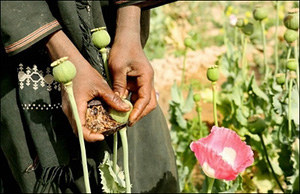 |
 |
 |
 News from Around the Americas | September 2006 News from Around the Americas | September 2006  
Afghanistan's Opium Production Jumps by Nearly 50 Percent: UN
 Agence France-Presse Agence France-Presse


| | Afghanistan produces 92 percent of the world's opium, most of which is used in Europe, Russia, China, Iran and Central Asia often as heroin. (AFP/John D McHugh) |
Afghanistan's opium production will increase by nearly 50 percent this year to a record 6,100 tonnes after an "alarming" jump in cultivation in the lawless south.

The area of land planted with opium - of which Afghanistan produces more than 90 percent of world supply - rose 59 percent this year as compared to last year, the United Nations Office on Drugs and Crime (UNODC) said Saturday.

The sharp increase in the number of acres planted would lead to a likely harvest of 6,100 tonnes - a 49 percent hike over the 4,100 tonnes produced the year before.

"This year's harvest will be around 6,100 tonnes of opium - a staggering 92 percent of total world supply. It exceeds global consumption by 30 percent," UNODC global executive director Antonio Maria Costa said in Kabul.

The hike comes despite government and international efforts costing millions of dollars to try to stop Afghanistan's trade in illegal opium, most of which ends up in the heroin markets of Europe and central Asia.

"These are very alarming numbers. Afghanistan is increasingly hooked on its own drug," Costa said after presenting the figures to President Hamid Karzai.

The spike follows a 21 percent drop in cultivation last year and a just over two percent dip in production. It was the first fall since the Taliban government was toppled in late 2001.

An annual UNODC survey found that the lawless southern province of Helmand planted 162 percent more opium this year than in 2005, accounting for more than 40 percent of the total area under cultivation.

In the country as a whole, the area of land planted with opium reached a record 165,000 hectares (407,550 acres) in 2006 compared with 104,000 last year, the UNODC statement said.

Officials have linked the drugs trade in Helmand, where the bulk of a British deployment of 4,750 troops is based, to an increase in attacks by Taliban insurgents and drugs traders who benefit from the insecurity.

The UNODC chief warned the southern part of Afghanistan showed "the ominous hallmarks of incipient collapse, with large-scale drug cultivation and trafficking, insurgency and terrorism, crime and corruption."

The UN survey, to be published in full next month, found that only six of Afghanistan's 34 provinces were free of opium. Cultivation fell this year in eight provinces, mainly in the north.

"Public opinion is increasingly frustrated by the fact that opium cultivation in Afghanistan is out of control," Costa said.

"The political, military and economic investments by coalition countries are not having much visible impact on drug cultivation."

"As a result, Afghan opium is fuelling insurgency in western Asia, feeding international mafias and causing a hundred thousand deaths from overdoses every year."

He said the government must take tougher action to defeat the drugs trade, including arresting major drug traffickers and wealthy opium-farming landlords, and seizing their assets.

Drug-free areas should be rewarded with more substantial development aid, and governors and police officials in charge of opium-growing provinces should be removed and charged, he said.

"This would draw a battle line in what could otherwise be an unwinnable war against insurgency mixed with drug trafficking," Costa said.

Improving living standards in the opium-growing area was also vital, he said, pointing out that Afghanistan - one of the world's poorest countries - had received less economic aid per person than other post-conflict areas.

The funds that had come in were not being caught up in bureaucracy or being misused and even stolen, Costa said.

He said Western nations also needed to curb drug abuse to try to stem the market for opium, 10 kilograms (22 pounds) of which can be used to make one kilogramme of heroin.

"Heroin habits in the West put huge sums of money into the pockets of criminals and insurgents who destabilise Afghanistan and kill soldiers and civilians alike," he said. | 
 | |
 |



